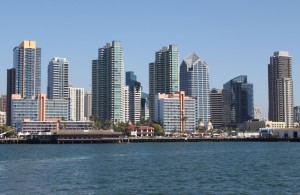A surveillance-mapping effort is underway in San Diego to make the city safer, according to the San Diego Police Department. But some residents are worried that a lack of oversight makes the on-going project a clear violation of privacy.
The goal of the project is for law enforcement officers to be able to view crimes while they are in progress. So in order to be able to do this, the SDPD is using government and city-owned surveillance cameras that are already in place, and also encouraging local business in the downtown area to volunteer their camera systems, effectively creating a surveillance network of both public and private cameras that officers can actually access live in their squad cars.
A tumblr had been set up that showed the location of the cameras that are up and running so far, which currently numbers around 40 (but it has since been removed). Hotel Indigo, located in San Diego’s downtown Gaslamp District, was the first to allow police to share their surveillance feed.
However, the main issue is whether or not there are proper (and transparent) guidelines in place that determines the rules for using this surveillance network. The SDPD claims that there are, and even posts on their website that they, “…have procedures in place that allow the viewing only when summoned to the Hotel Indigo (or any additional partner) for a service call.”
A San Diego resident named Jeff Hammett decided he wanted to see said procedures, so he filed a public records act to obtain them. His efforts were unsuccessful, however, because according to the response he received from the SDPD, the procedures don’t exist. They wrote, “There are no responsive documents for your request to any copies of procedures regarding viewing these camera feeds. Operation Secure San Diego is still in the development stages. There are no procedures at this time.”
This is disconcerting, seeing as the Hotel Indigo has been, according to UT San Diego, sharing their surveillance feed with the police since 2010, meaning that for four years now, there has been zero oversight to identify possible violations of privacy. The article did say that police are only allowed to view the streaming footage live and that they are not allowed to record any of it. However, with no oversight in place, clearly no one is around to enforce such a “rule.”
Increasing use of surveillance has upset many citizens who value their privacy. Although there are public safety benefits with utilizing a widespread surveillance network, the public will be suspicious of these programs until there are transparent protocols in place and open discussions regarding their use.
